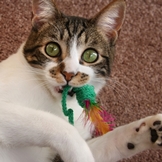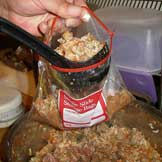
I just finished listening to a podcast produced by the Public Radio show Science Friday called the “Fallacies of Fat.” In it, Dr. Robert Lustig talks about diet, exercise, weight loss, and health and how they are not all related in the ways that you might think.
Dr. Lustig is a medical doctor, not a veterinarian, but I think some of his points could have important implications when it comes to the well being of dogs and cats. I’m going to talk about diabetes and cats here. For my take on weight loss and dogs, head on over to today’s canine version of Nutrition Nuggets.
Diabetes mellitus is on the rise in household cats. Its incidence is currently estimated at 1 in 200-250 cats (0.5%). That may not sound like much until you realize that the American Veterinary Medical Association estimates that 74,059,000 pet cats were residing in the United States as of 2012. One half of one percent of that number turns out to be 370,295 — that’s a lot of diabetic cats.
The vast majority of cats have what is called type 2 diabetes, meaning that the pancreas is still producing normal amounts of insulin (at least early in the course of the disease), but the rest of the body has a reduced ability to respond to it (insulin resistance). Obesity is associated with an increased incidence of insulin resistance and raises the risk of a cat developing diabetes three to five-fold, so it’s not surprising that veterinarians tend to discuss weight loss as an important way to prevent and treat diabetes in cats. But that emphasis may be slightly off the mark.
Dr. Lustig quotes the statistic that 40% of thin people have metabolic syndrome and are therefore on the road to developing type 2 diabetes. In other words, these people are thin but sick. Other folks are what he calls “fat and fit.” The difference is exercise. Even a moderate amount of exercise is enough to reduce the amount of belly (visceral) fat that is directly linked to metabolic syndrome and type 2 diabetes. This is true even if the amount of peripheral (subcutaneous) fat remains relatively unchanged. According to Dr. Lustig, exercise builds muscle, which increases the number of mitochondria where energy is burned. Large numbers of mitochondria are harder to overload so the body makes less visceral fat as a result.
Perhaps veterinarians and owners should be focusing more on increasing the amount of exercise cats get and a little less on how fat they appear to be. Thankfully, we’re not talking exercise on the level of Olympic training here. Simply encouraging cats to move around the house more should suffice.
- Place the food bowl in an out of the way location so cats have to put some effort into getting their meals. Forcing them to go up and down stairs is ideal.
- Play with your cat. Toss a “mouse” down the hall or purchase a kitty “fishing pole” or laser pointer to get him or her moving again.
Diet is the other critical component to managing feline diabetes. Simple carbohydrates are the enemy when it comes to managing the disease. They cause rapid increases in blood sugar levels that overload the body’s ability to cope.
Foods that are high in protein and low in carbohydrates are appropriate for most cats with or at risk for developing diabetes. The carbohydrates that are present should contain a lot of fiber, which helps to slow their absorption from the intestinal tract. This type of diet generally also helps cats lose weight, but Dr. Lustig’s presentation makes me think that we should be seeing that more as a happy coincidence rather than the main point of managing diabetes in cats.

Dr. Jennifer Coates
Image: Photohunter / Shutterstock









